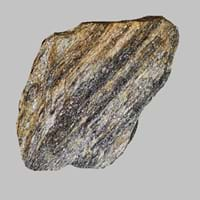Gabbro and Mylonite
Definition
Definition
Gabbro is an intrusive igneous rock which is chemically equivalent to plutonic Basalt
Mylonite is a metamorphic rock formed by ductile deformation during intense shearing encountered during folding and faulting, a process termed cataclastic or dynamic metamorphism
History
Origin
Germany
New Zealand
Discoverer
Christian Leopold von Buch
Unknown
Etymology
From Latin glaber bare, smooth, bald
From Greek mulōn mill + -ite
Class
Igneous Rocks
Metamorphic Rocks
Sub-Class
Durable Rock, Hard Rock
Durable Rock, Medium Hardness Rock
Family
Group
Plutonic
Not Applicable
Other Categories
Coarse Grained Rock, Opaque Rock
Fine Grained Rock, Opaque Rock
Texture
Texture
Phaneritic
Foliated
Color
Dark Grey to Black
Black to Grey
Maintenance
Less
Less
Durability
Durable
Durable
Water Resistant
Yes
Yes
Scratch Resistant
Yes
Yes
Stain Resistant
Yes
No
Wind Resistant
Yes
No
Acid Resistant
Yes
No
Appearance
Veined and Shiny
Dull, Banded and Foilated
Uses
Architecture
Interior Uses
Countertops, Decorative Aggregates, Homes, Interior Decoration
Decorative Aggregates, Interior Decoration
Exterior Uses
As Building Stone, As Facing Stone, Garden Decoration, Office Buildings, Paving Stone
As Building Stone, As Facing Stone, Paving Stone, Garden Decoration
Other Architectural Uses
Curbing
Curbing
Industry
Construction Industry
As Dimension Stone, Building houses or walls, Cement Manufacture, Construction Aggregate, for Road Aggregate
for Road Aggregate, Landscaping, Roadstone
Medical Industry
Not Yet Used
Not Yet Used
Antiquity Uses
Artifacts, Monuments, Sculpture
Artifacts, Monuments
Other Uses
Commercial Uses
Cemetery Markers, Commemorative Tablets, Laboratory bench tops, Jewelry, Sea Defence, Tombstones
Creating Artwork, Gemstone, Jewelry
Types
Types
Not Available
Blastomylonites, Ultramylonites and Phyllonites
Features
Smooth to touch
Surfaces are often shiny
Archaeological Significance
Monuments
Used
Used
Famous Monuments
Data Not Available
Data Not Available
Sculpture
Used
Used
Famous Sculptures
Data Not Available
Data Not Available
Pictographs
Not Used
Used
Petroglyphs
Not Used
Used
Figurines
Used
Used
Fossils
Absent
Absent
Formation
Formation
Gabbro, a mafic rock, forms due to cooling and crystallization of magma underneath Earth's surface.
Mylonites are ductilely deformed rocks formed by the accumulation of large shear strain, in ductile fault zones.
Composition
Mineral Content
Augite, Olivine, Plagioclase, Pyroxene
Porphyroblasts
Compound Content
Aluminium Oxide, CaO, Chromium(III) Oxide, Iron(III) Oxide, Potassium Oxide, MgO, Sodium Oxide, Silicon Dioxide, Sulfur Trioxide
Aluminium Oxide, Calcium Sulfate, Chromium(III) Oxide, Iron(III) Oxide, Magnesium Carbonate, Silicon Dioxide
Transformation
Metamorphism
Yes
No
Types of Metamorphism
Impact Metamorphism
Not Applicable
Weathering
Yes
Yes
Types of Weathering
Chemical Weathering
Biological Weathering, Chemical Weathering, Mechanical Weathering
Erosion
Yes
Yes
Types of Erosion
Coastal Erosion
Chemical Erosion, Sea Erosion, Wind Erosion
Properties
Physical Properties
Hardness
7
3-4
Grain Size
Coarse Grained
Fine Grained
Fracture
Conchoidal
Conchoidal
Streak
Black
White
Porosity
Highly Porous
Highly Porous
Luster
Not Available
Shiny
Compressive Strength
225.00 N/mm2
7
1.28 N/mm2
32
Cleavage
Not Available
Conchoidal
Toughness
1.6
Not Available
Specific Gravity
2.86-2.87
2.97-3.05
Transparency
Opaque
Opaque
Density
2.7-3.3 g/cm3
2.6-4.8 g/cm3
Thermal Properties
Specific Heat Capacity
Not Available
1.50 kJ/Kg K
3
Resistance
Impact Resistant, Pressure Resistant, Wear Resistant
Heat Resistant, Impact Resistant, Pressure Resistant
Reserves
Deposits in Eastern Continents
Asia
India, Russia
China, India, Indonesia, Saudi Arabia, South Korea
Africa
South Africa
Eritrea, Ethiopia, Ghana, South Africa, Western Africa
Europe
Germany, Greece, Italy, Scotland, Turkey
England, Finland, France, Germany, Great Britain, Greece, United Kingdom
Others
Greenland
Not Yet Found
Deposits in Western Continents
North America
Canada, USA
USA
South America
Brazil, Colombia, Venezuela
Not Yet Found
Deposits in Oceania Continent
Australia
New Zealand, Queensland
Central Australia, Western Australia
All about Gabbro and Mylonite Properties
Know all about Gabbro and Mylonite properties here. All properties of rocks are important as they define the type of rock and its application. Gabbro belongs to Igneous Rocks while Mylonite belongs to Metamorphic Rocks.Texture of Gabbro is Phaneritic whereas that of Mylonite is Foliated. Gabbro appears Veined and Shiny and Mylonite appears Dull, Banded and Foilated. The luster of Gabbro is not available while that of Mylonite is shiny. Gabbro is available in dark grey to black colors whereas Mylonite is available in black to grey colors. The commercial uses of Gabbro are cemetery markers, commemorative tablets, laboratory bench tops, jewelry, sea defence, tombstones and that of Mylonite are creating artwork, gemstone, jewelry.
|
||
|
||
|










